标签:
本篇主要为Python 类的成员、成员修饰符、类的特殊成员。
类的成员
类的成员可以分为三大类:字段、方法和属性
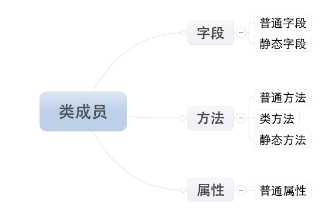
注:所有成员中,只有普通字段的内容保存对象中,即:根据此类创建了多少对象,在内存中就有多少个普通字段。而其他的成员,则都是保存在类中,即:无论对象的多少,在内存中只创建一份。
一、字段
字段包括:普通字段和静态字段,他们在定义和使用中有所区别,而最本质的区别是内存中保存的位置不同,

1 class Province: 2 3 # 静态字段 4 country = ‘中国‘ 5 6 def __init__(self, name): 7 8 # 普通字段 9 self.name = name 10 11 12 # 直接访问普通字段 13 obj = Province(‘河北省‘) 14 print obj.name 15 16 # 直接访问静态字段 17 Province.country
由上述代码可以看出【普通字段需要通过对象来访问】【静态字段通过类访问】,在使用上可以看出普通字段和静态字段的归属是不同的。其在内容的存储方式类似如下图:
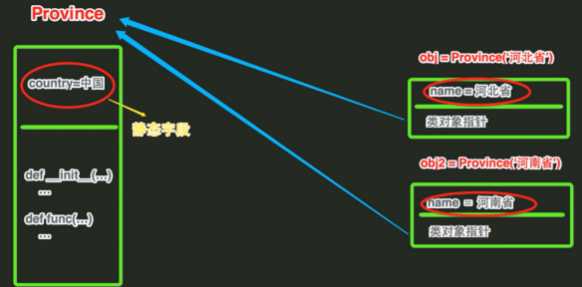
由上图可是:
应用场景: 通过类创建对象时,如果每个对象都具有相同的字段,那么就使用静态字段
二、方法
方法包括:普通方法、静态方法和类方法,三种方法在内存中都归属于类,区别在于调用方式不同。

1 class Foo: 2 3 def __init__(self, name): 4 self.name = name 5 6 def ord_func(self): 7 """ 定义普通方法,至少有一个self参数 """ 8 9 # print self.name 10 print ‘普通方法‘ 11 12 @classmethod 13 def class_func(cls): 14 """ 定义类方法,至少有一个cls参数 """ 15 16 print ‘类方法‘ 17 18 @staticmethod 19 def static_func(): 20 """ 定义静态方法 ,无默认参数""" 21 22 print ‘静态方法‘ 23 24 25 # 调用普通方法 26 f = Foo() 27 f.ord_func() 28 29 # 调用类方法 30 Foo.class_func() 31 32 # 调用静态方法 33 Foo.static_func()
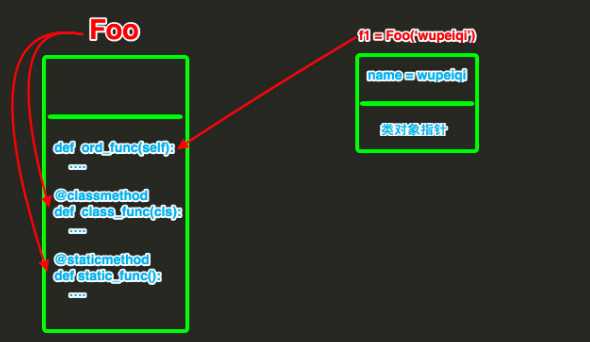
相同点:对于所有的方法而言,均属于类(非对象)中,所以,在内存中也只保存一份。
不同点:方法调用者不同、调用方法时自动传入的参数不同。
三、属性
如果你已经了解Python类中的方法,那么属性就非常简单了,因为Python中的属性其实是普通方法的变种。
对于属性,有以下三个知识点:
1、属性的基本使用

1 # ############### 定义 ############### 2 class Foo: 3 4 def func(self): 5 pass 6 7 # 定义属性 8 @property 9 def prop(self): 10 pass 11 # ############### 调用 ############### 12 foo_obj = Foo() 13 14 foo_obj.func() 15 foo_obj.prop #调用属性
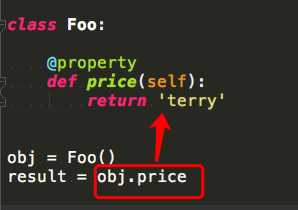
由属性的定义和调用要注意一下几点:
注意:属性存在意义是:访问属性时可以制造出和访问字段完全相同的假象
属性由方法变种而来,如果Python中没有属性,方法完全可以代替其功能。
实例:对于主机列表页面,每次请求不可能把数据库中的所有内容都显示到页面上,而是通过分页的功能局部显示,所以在向数据库中请求数据时就要显示的指定获取从第m条到第n条的所有数据(即:limit m,n),这个分页的功能包括:

# ############### 定义 ############### class Pager: def __init__(self, current_page): # 用户当前请求的页码(第一页、第二页...) self.current_page = current_page # 每页默认显示10条数据 self.per_items = 10 @property def start(self): val = (self.current_page - 1) * self.per_items return val @property def end(self): val = self.current_page * self.per_items return val # ############### 调用 ############### p = Pager(1) p.start 就是起始值,即:m p.end 就是结束值,即:n
从上述可见,Python的属性的功能是:属性内部进行一系列的逻辑计算,最终将计算结果返回。
2、属性的两种定义方式
属性的定义有两种方式:
装饰器方式:在类的普通方法上应用@property装饰器

# ############### 定义 ############### class Goods: @property def price(self): return "terry" # ############### 调用 ############### obj = Goods() result = obj.price # 自动执行 @property 修饰的 price 方法,并获取方法的返回值
具有三种@property装饰器的情况

1 # ############### 定义 ############### 2 class Goods(object): 3 4 @property 5 def price(self): 6 print ‘@property‘ 7 8 @price.setter 9 def price(self, value): 10 print ‘@price.setter‘ 11 12 @price.deleter 13 def price(self): 14 print ‘@price.deleter‘ 15 16 # ############### 调用 ############### 17 obj = Goods() 18 19 obj.price # 自动执行 @property 修饰的 price 方法,并获取方法的返回值 20 21 obj.price = 123 # 自动执行 @price.setter 修饰的 price 方法,并将 123 赋值给方法的参数 22 23 del obj.price # 自动执行 @price.deleter 修饰的 price 方法
由于有三种访问方式,我们可以根据他们几个属性的访问特点,分别将三个方法定义为对同一个属性:获取、修改、删除

1 class Goods(object): 2 3 def __init__(self): 4 # 原价 5 self.original_price = 100 6 # 折扣 7 self.discount = 0.8 8 9 @property 10 def price(self): 11 # 实际价格 = 原价 * 折扣 12 new_price = self.original_price * self.discount 13 return new_price 14 15 @price.setter 16 def price(self, value): 17 self.original_price = value 18 19 @price.deltter 20 def price(self, value): 21 del self.original_price 22 23 obj = Goods() 24 obj.price # 获取商品价格 25 obj.price = 200 # 修改商品原价 26 del obj.price # 删除商品原价
静态字段方式,创建值为property对象的静态字段
当使用静态字段的方式创建属性时,经典类和新式类无区别

1 class Foo: 2 3 def get_bar(self): 4 return ‘terry‘ 5 6 BAR = property(get_bar) 7 8 obj = Foo() 9 reuslt = obj.BAR # 自动调用get_bar方法,并获取方法的返回值 10 print reuslt
property的构造方法中有个四个参数
对象.属性 时自动触发执行方法对象.属性 = XXX 时自动触发执行方法del 对象.属性 时自动触发执行方法对象.属性.__doc__ ,此参数是该属性的描述信息
class Foo: def get_bar(self): return ‘terry‘ # *必须两个参数 def set_bar(self, value): return return ‘set value‘ + value def del_bar(self): return ‘terry‘ BAR = property(get_bar, set_bar, del_bar, ‘description...‘) obj = Foo() obj.BAR # 自动调用第一个参数中定义的方法:get_bar obj.BAR = "alex" # 自动调用第二个参数中定义的方法:set_bar方法,并将“alex”当作参数传入 del Foo.BAR # 自动调用第三个参数中定义的方法:del_bar方法 obj.BAE.__doc__ # 自动获取第四个参数中设置的值:description...
由于静态字段方式创建属性具有三种访问方式,我们可以根据他们几个属性的访问特点,分别将三个方法定义为对同一个属性:获取、修改、删除

1 class Goods(object): 2 3 def __init__(self): 4 # 原价 5 self.original_price = 100 6 # 折扣 7 self.discount = 0.8 8 9 def get_price(self): 10 # 实际价格 = 原价 * 折扣 11 new_price = self.original_price * self.discount 12 return new_price 13 14 def set_price(self, value): 15 self.original_price = value 16 17 def del_price(self, value): 18 del self.original_price 19 20 PRICE = property(get_price, set_price, del_price, ‘价格属性描述...‘) 21 22 obj = Goods() 23 obj.PRICE # 获取商品价格 24 obj.PRICE = 200 # 修改商品原价 25 del obj.PRICE # 删除商品原价
注意:Python WEB框架 Django 的视图中 request.POST 就是使用的静态字段的方式创建的属性

1 class WSGIRequest(http.HttpRequest): 2 def __init__(self, environ): 3 script_name = get_script_name(environ) 4 path_info = get_path_info(environ) 5 if not path_info: 6 # Sometimes PATH_INFO exists, but is empty (e.g. accessing 7 # the SCRIPT_NAME URL without a trailing slash). We really need to 8 # operate as if they‘d requested ‘/‘. Not amazingly nice to force 9 # the path like this, but should be harmless. 10 path_info = ‘/‘ 11 self.environ = environ 12 self.path_info = path_info 13 self.path = ‘%s/%s‘ % (script_name.rstrip(‘/‘), path_info.lstrip(‘/‘)) 14 self.META = environ 15 self.META[‘PATH_INFO‘] = path_info 16 self.META[‘SCRIPT_NAME‘] = script_name 17 self.method = environ[‘REQUEST_METHOD‘].upper() 18 _, content_params = cgi.parse_header(environ.get(‘CONTENT_TYPE‘, ‘‘)) 19 if ‘charset‘ in content_params: 20 try: 21 codecs.lookup(content_params[‘charset‘]) 22 except LookupError: 23 pass 24 else: 25 self.encoding = content_params[‘charset‘] 26 self._post_parse_error = False 27 try: 28 content_length = int(environ.get(‘CONTENT_LENGTH‘)) 29 except (ValueError, TypeError): 30 content_length = 0 31 self._stream = LimitedStream(self.environ[‘wsgi.input‘], content_length) 32 self._read_started = False 33 self.resolver_match = None 34 35 def _get_scheme(self): 36 return self.environ.get(‘wsgi.url_scheme‘) 37 38 def _get_request(self): 39 warnings.warn(‘`request.REQUEST` is deprecated, use `request.GET` or ‘ 40 ‘`request.POST` instead.‘, RemovedInDjango19Warning, 2) 41 if not hasattr(self, ‘_request‘): 42 self._request = datastructures.MergeDict(self.POST, self.GET) 43 return self._request 44 45 @cached_property 46 def GET(self): 47 # The WSGI spec says ‘QUERY_STRING‘ may be absent. 48 raw_query_string = get_bytes_from_wsgi(self.environ, ‘QUERY_STRING‘, ‘‘) 49 return http.QueryDict(raw_query_string, encoding=self._encoding) 50 51 # ############### 看这里看这里 ############### 52 def _get_post(self): 53 if not hasattr(self, ‘_post‘): 54 self._load_post_and_files() 55 return self._post 56 57 # ############### 看这里看这里 ############### 58 def _set_post(self, post): 59 self._post = post 60 61 @cached_property 62 def COOKIES(self): 63 raw_cookie = get_str_from_wsgi(self.environ, ‘HTTP_COOKIE‘, ‘‘) 64 return http.parse_cookie(raw_cookie) 65 66 def _get_files(self): 67 if not hasattr(self, ‘_files‘): 68 self._load_post_and_files() 69 return self._files 70 71 # ############### 看这里看这里 ############### 72 POST = property(_get_post, _set_post) 73 74 FILES = property(_get_files) 75 REQUEST = property(_get_request)
所以,定义属性共有两种方式,分别是【装饰器】和【静态字段】,而【装饰器】方式针对经典类和新式类又有所不同。
类的所有成员在上一步骤中已经做了详细的介绍,对于每一个类的成员而言都有两种形式:
私有成员和公有成员的定义不同:私有成员命名时,前两个字符是下划线。(特殊成员除外,例如:__init__、__call__、__dict__等)
class C: def __init__(self): self.name = ‘公有字段‘ self.__foo = "私有字段"
私有成员和公有成员的访问限制不同:
静态字段

1 class C: 2 3 name = "公有静态字段" 4 5 def func(self): 6 print C.name 7 8 class D(C): 9 10 def show(self): 11 print C.name 12 13 14 C.name # 类访问 15 16 obj = C() 17 obj.func() # 类内部可以访问 18 19 obj_son = D() 20 obj_son.show() # 派生类中可以访问

1 class C: 2 3 __name = "公有静态字段" 4 5 def func(self): 6 print C.__name 7 8 class D(C): 9 10 def show(self): 11 print C.__name 12 13 14 C.__name # 类访问 ==> 错误 15 16 obj = C() 17 obj.func() # 类内部可以访问 ==> 正确 18 19 obj_son = D() 20 obj_son.show() # 派生类中可以访问 ==> 错误
普通字段
ps:如果想要强制访问私有字段,可以通过 【对象._类名__私有字段明 】访问(如:obj._C__foo),不建议强制访问私有成员。
上文介绍了Python的类成员以及成员修饰符,从而了解到类中有字段、方法和属性三大类成员,并且成员名前如果有两个下划线,则表示该成员是私有成员,私有成员只能由类内部调用。无论人或事物往往都有不按套路出牌的情况,Python的类成员也是如此,存在着一些具有特殊含义的成员,详情如下:
1. __doc__
表示类的描述信息

1 class Foo: 2 """ 描述类信息,这是用于看片的神奇 """ 3 4 def func(self): 5 pass 6 7 print Foo.__doc__ 8 #输出:类的描述信息
2. __module__ 和 __class__
__module__ 表示当前操作的对象在那个模块
__class__ 表示当前操作的对象的类是什么

1 #!/usr/bin/env python 2 # -*- coding:utf-8 -*- 3 4 class C: 5 6 def __init__(self): 7 self.name = ‘terry‘

from lib.aa import C obj = C() print obj.__module__ # 输出 lib.aa,即:输出模块 print obj.__class__ # 输出 lib.aa.C,即:输出类
3. __init__
构造方法,通过类创建对象时,自动触发执行。

class Foo: def __init__(self, name): self.name = name self.age = 18 obj = Foo(‘terry‘) # 自动执行类中的 __init__ 方法
4. __del__
析构方法,当对象在内存中被释放时,自动触发执行。
注:此方法一般无须定义,因为Python是一门高级语言,程序员在使用时无需关心内存的分配和释放,因为此工作都是交给Python解释器来执行,所以,析构函数的调用是由解释器在进行垃圾回收时自动触发执行的。

1 class Foo: 2 3 def __del__(self): 4 pass
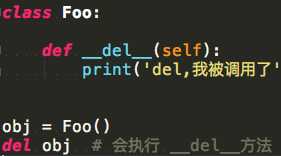

5. __call__
对象后面加括号,触发执行。
注:构造方法的执行是由创建对象触发的,即:对象 = 类名() ;而对于 __call__ 方法的执行是由对象后加括号触发的,即:对象() 或者 类()()

class Foo: def __init__(self): pass def __call__(self, *args, **kwargs): print ‘__call__‘ obj = Foo() # 执行 __init__ obj() # 执行 __call__
6. __dict__
类或对象中的所有成员
上文中我们知道:类的普通字段属于对象;类中的静态字段和方法等属于类,即:
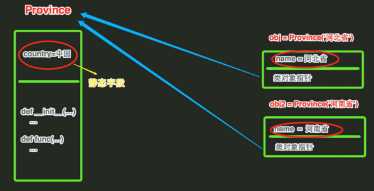

class Province: country = ‘China‘ def __init__(self, name, count): self.name = name self.count = count def func(self, *args, **kwargs): print ‘func‘ # 获取类的成员,即:静态字段、方法、 print Province.__dict__ # 输出:{‘country‘: ‘China‘, ‘__module__‘: ‘__main__‘, ‘func‘: <function func at 0x10be30f50>, ‘__init__‘: <function __init__ at 0x10be30ed8>, ‘__doc__‘: None} obj1 = Province(‘HeBei‘,10000) print obj1.__dict__ # 获取 对象obj1 的成员 # 输出:{‘count‘: 10000, ‘name‘: ‘HeBei‘} obj2 = Province(‘HeNan‘, 3888) print obj2.__dict__ # 获取 对象obj1 的成员 # 输出:{‘count‘: 3888, ‘name‘: ‘HeNan‘}
7. __str__
如果一个类中定义了__str__方法,那么在打印 对象 时,默认输出该方法的返回值。
class Foo: def __str__(self): return ‘terry‘ obj = Foo() print obj # 输出:terry
8、__getitem__、__setitem__、__delitem__
用于索引操作,如字典。以上分别表示获取、设置、删除数据

1 #!/usr/bin/env python 2 # -*- coding:utf-8 -*- 3 4 class Foo(object): 5 6 def __getitem__(self, key): 7 print ‘__getitem__‘,key 8 9 def __setitem__(self, key, value): 10 print ‘__setitem__‘,key,value 11 12 def __delitem__(self, key): 13 print ‘__delitem__‘,key 14 15 16 obj = Foo() 17 18 result = obj[‘k1‘] # 自动触发执行 __getitem__ 19 obj[‘k2‘] = ‘wupeiqi‘ # 自动触发执行 __setitem__ 20 del obj[‘k1‘] # 自动触发执行 __delitem__
9、__getslice__、__setslice__、__delslice__
该三个方法用于分片操作,如:列表

1 #!/usr/bin/env python 2 # -*- coding:utf-8 -*- 3 4 class Foo(object): 5 6 def __getslice__(self, i, j): 7 print ‘__getslice__‘,i,j 8 9 def __setslice__(self, i, j, sequence): 10 print ‘__setslice__‘,i,j 11 12 def __delslice__(self, i, j): 13 print ‘__delslice__‘,i,j 14 15 obj = Foo() 16 17 obj[-1:1] # 自动触发执行 __getslice__ 18 obj[0:1] = [11,22,33,44] # 自动触发执行 __setslice__ 19 del obj[0:2] # 自动触发执行 __delslice__
10. __iter__
用于迭代器,之所以列表、字典、元组可以进行for循环,是因为类型内部定义了 __iter__

1 class Foo(object): 2 pass 3 4 5 obj = Foo() 6 7 for i in obj: 8 print i 9 10 # 报错:TypeError: ‘Foo‘ object is not iterable

1 #!/usr/bin/env python 2 # -*- coding:utf-8 -*- 3 4 class Foo(object): 5 6 def __iter__(self): 7 pass 8 9 obj = Foo() 10 11 for i in obj: 12 print i 13 14 # 报错:TypeError: iter() returned non-iterator of type ‘NoneType‘

1 #!/usr/bin/env python 2 # -*- coding:utf-8 -*- 3 4 class Foo(object): 5 6 def __init__(self, sq): 7 self.sq = sq 8 9 def __iter__(self): 10 return iter(self.sq) 11 12 obj = Foo([11,22,33,44]) 13 14 for i in obj: 15 print i
以上步骤可以看出,for循环迭代的其实是 iter([11,22,33,44]) ,所以执行流程可以变更为:
#!/usr/bin/env python # -*- coding:utf-8 -*- obj = iter([11,22,33,44]) for i in obj: print i

1 #!/usr/bin/env python 2 # -*- coding:utf-8 -*- 3 4 obj = iter([11,22,33,44]) 5 6 while True: 7 val = obj.next() 8 print val
11. __new__ 和 __metaclass__
阅读以下代码:
class Foo(object): def __init__(self): pass obj = Foo() # obj是通过Foo类实例化的对象
上述代码中,obj 是通过 Foo 类实例化的对象,其实,不仅 obj 是一个对象,Foo类本身也是一个对象,因为在Python中一切事物都是对象。
如果按照一切事物都是对象的理论:obj对象是通过执行Foo类的构造方法创建,那么Foo类对象应该也是通过执行某个类的 构造方法 创建。
print type(obj) # 输出:<class ‘__main__.Foo‘> 表示,obj 对象由Foo类创建 print type(Foo) # 输出:<type ‘type‘> 表示,Foo类对象由 type 类创建
所以,obj对象是Foo类的一个实例,Foo类对象是 type 类的一个实例,即:Foo类对象 是通过type类的构造方法创建。
那么,创建类就可以有两种方式:
a). 普通方式
class Foo(object): def func(self): print ‘hello terry‘
b).特殊方式(type类的构造函数)
def func(self):
print ‘hello terry‘
Foo = type(‘Foo‘,(object,), {‘func‘: func})
#type第一个参数:类名
#type第二个参数:当前类的基类
#type第三个参数:类的成员
==》 类 是由 type 类实例化产生
那么问题来了,类默认是由 type 类实例化产生,type类中如何实现的创建类?类又是如何创建对象?
答:类中有一个属性 __metaclass__,其用来表示该类由 谁 来实例化创建,所以,我们可以为 __metaclass__ 设置一个type类的派生类,从而查看 类 创建的过程。
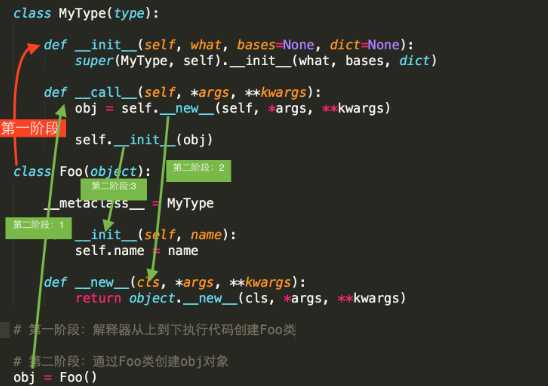

class MyType(type): def __init__(self, what, bases=None, dict=None): super(MyType, self).__init__(what, bases, dict) def __call__(self, *args, **kwargs): obj = self.__new__(self, *args, **kwargs) self.__init__(obj) class Foo(object): __metaclass__ = MyType def __init__(self, name): self.name = name def __new__(cls, *args, **kwargs): return object.__new__(cls, *args, **kwargs) # 第一阶段:解释器从上到下执行代码创建Foo类 # 第二阶段:通过Foo类创建obj对象 obj = Foo()
标签:
原文地址:http://www.cnblogs.com/terrycy/p/5880809.html